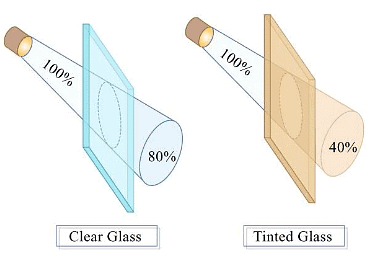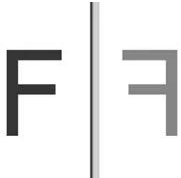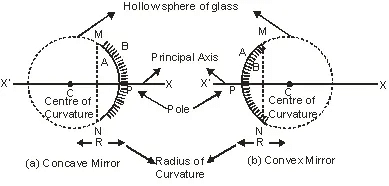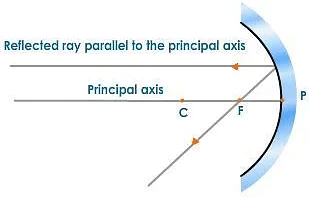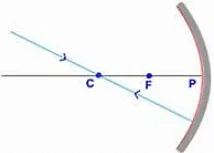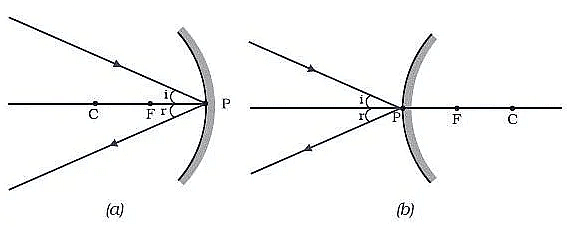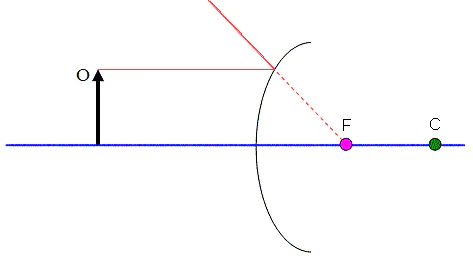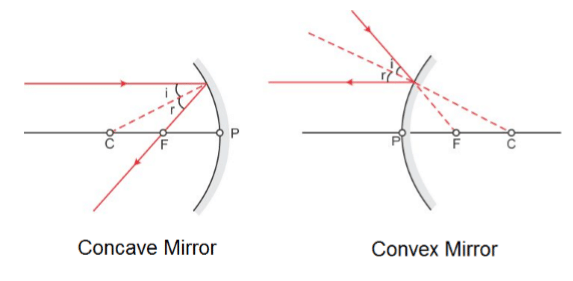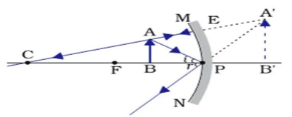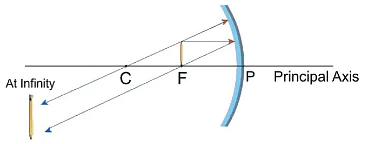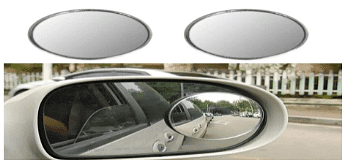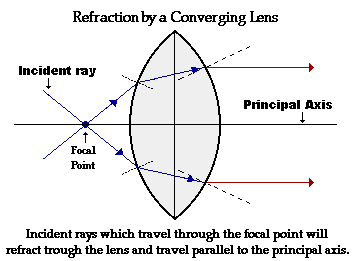Light | Science Olympiad for Class 10 PDF Download
Introduction
We all are familiar with light and its importance. Light is such an important source that without it all colorful things would have been black for us. So let us see how we can define such an important source. Light is a form of energy that enables us to see around us or we can say that it is an electromagnetic wave that can travel through any medium as well as through vacuum.
Types of objects
There are two types of objects as follows:
(i) Luminous Objects: They are those which have their own light. We can see them as they have their own light. When their light reaches our eyes that is the time when we can see them. For example: we have sun, tubelight, etc. It is not necessary that it should possess light naturally. If any substance glows on passing current, that also falls under the same category.
(ii) Non Luminous Objects: They are those which do not have their own light. So, if there is no light, we can’t see them. To see, we need a luminous object around it. For example: furniture, walls, moon, etc.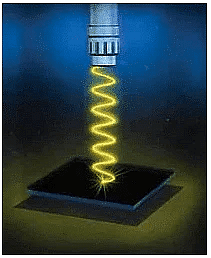
If we talk about the tendency of light that how it gets affected when it falls on any surface, then we conclude that when light falls on any surface, either of these phenomena takes place:
- Light falling on a surface: It may get absorbed. The surface that absorbs all the light falling on it appears to be black in colour, or in other words we say that black is a good absorber and emitter of light.
- When light falls on the surface it may pass through it: But it is not that all light rays would pass. Certain substances allow all rays to pass and few substances allow only certain rays to pass. Those substances which allow all rays to pass appear to be transparent. The process of allowing rays to pass through is called transmit process.
For example: glass is transparent as it allows all rays to pass through it. In this figure we have tinted a plane glass. You can easily notice that tinted glass allows only a few rays to pass and on the other hand, plane glass allows all rays to pass through it.
- Light falling on a surface may strike the surface and bounce back: This striking and bouncing back of light rays is called reflection. For example: we all often look in the mirror at home when we dress up. We can look at ourselves just because of the phenomenon of reflection.

Reflection
As we have discussed about reflection so now we are going to define it. “Reflection is the bouncing back of light rays on striking the surface”. As you can see the picture given below, that in it the ray is striking the surface and then it bounces back.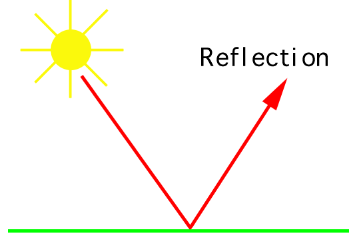 There are many surfaces that show reflection but not all surfaces show reflection. To show reflection, there are certain characteristics that must be fulfilled as given below.
There are many surfaces that show reflection but not all surfaces show reflection. To show reflection, there are certain characteristics that must be fulfilled as given below.
(i) Characteristics of Best Reflector:
- Shiny Surface: A good reflector should have a shiny surface that can bounce back light effectively.
- Polished Surface: The surface should be polished to enhance its reflective properties.
- Smooth Surface: A smooth surface is essential for optimal reflection as it minimizes any distortion of the reflected light.
Out of all, silver metal is the best reflector as it fulfills all the above discussed features.
(ii) Terminology involved in case of reflection:
Look at the figure to understand this in a better way.
- Incident Ray: It is the ray that strikes the surface.
- Point of Incidence: It is the point at which the incident ray strikes the surface.
- Reflected Ray: The ray that bounces back on striking the surface.
- Normal Ray: The perpendicular drawn to surface.
- Angle of Incidence: The angle between the incident ray and the normal ray.
- Angle of Reflection: The angle between the reflected ray and the normal ray.
- Plane of Reflection: Plane where incident ray reflected ray and normal ray lies.
(iii) Laws Of Reflection
These are certain sets of laws that are obeyed by all surfaces that show reflection.
- 1st law of reflection: Incident ray, reflected ray and normal ray all lie on the same plane.
- 2nd law of reflection: Angle of incidence is always equal to the angle of reflection.
Types Of Sources Of Light
As we know, there are different objects that emit light so, depending upon the size of object, we have two types of sources of light:
- Point Sources
- Finite Sources
(i) Point Sources: These are those sources that are too small in size as shown in the figure.
(ii) Finite Sources: These are the sources that have certain height as shown in figure. The given diagram candle has certain length and is regarded as a finite source.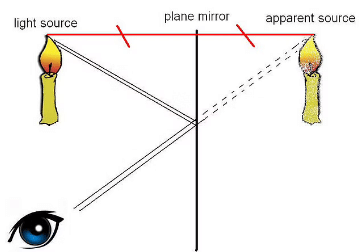
Types Of Mirror
Mirrors show the phenomenon of reflection so, depending upon the type of reflecting surface of mirrors, we have two types of mirrors, as follows: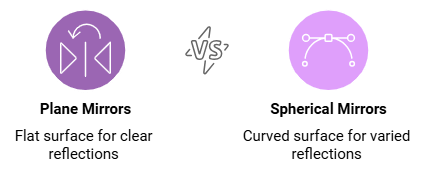
(i) Plane Mirror: Plane mirrors are those that have plane reflecting surface as shown in the figure.
(ii) Spherical Mirror: Spherical mirrors are the other types that have a curved reflecting surface. They are generally of two types i.e., one with a bulge and other with a depression.
Types of spherical mirrors
- Concave mirror
- Convex mirror
The bulged one is convex mirror and the one with depression is concave mirror
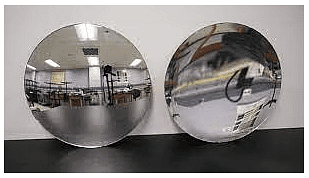
(i) Concave mirror: It is that in which the reflection occurs through inner surface of mirror.
(ii) Convex mirror: It is that in which the reflection occurs through outer surface of mirror.
Types Of Images
An image is formed when the reflected rays actually meet or appear to meet at a certain point. Accordingly, two types of images are formed depending upon whether the reflected rays meet or not. We have two types of images:
- Real images
- Virtual images
(i) Real Image:
- It is that which is formed when reflected rays actually meet at a certain point.
- It is always inverted.
- It can be obtained on screen.
(ii) Virtual Image:
- It is that which is formed when reflected rays do not meet actually but appear to meet at a certain point.
- It is always erect.
- It can’t be obtained on a screen.
Image formed by plane mirror when point object is kept in front of it
In this many light rays are emitted by the candle flame but in order to make a ray diagram, we have to consider at least two rays. We consider the two rays that are striking the mirror at different angles. Let’s say, one striking at normal to mirror and the other at a certain angle. The normal ray retraces its path and the other ray striking at a certain angle is reflected by the same angle. When we produce both the reflected rays, they appear to meet at a certain point and there the image is formed.
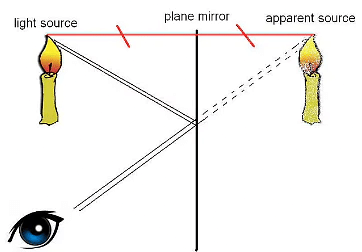
Characteristics Of Image
- Virtual
- Erect
- Same Size
- Distance Of Object = Distance Of Image From Mirror
- Laterally Inverted

Lateral Inversion
- It is the phenomenon when LHS becomes RHS or vice-versa, when an object is exposed to a plane mirror.
- Spherical Mirrors: We have two types of spherical mirrors as discussed – concave and convex.
- Aperture: It is the part of a spherical mirror from which the reflection actually occurs.

- Centre of curvature: It is the centre of the spherical mirror.
- Principal Axis: The line passing straight through C.
- Pole: It is the point where Polar axis strikes the mirror.
- Focus: It is the point where all reflected rays meet or appear to meet.
- Focal Length: The distance between focus and pole.
- Relation between focal length and radius of curvature.
F = R/2 (focal length is always half of radius)
Rules to obtain image from concave mirror
- 1st rule: The incident ray that comes parallel to the polar axis after reflection, passes through the focus as shown.

- 2nd rule: The incident ray coming from focus after reflection becomes parallel to the polar axis.

- 3rd rule: The incident ray coming through ‘C’ retraces its path.
- 4th rule: The Incident ray striking at pole by a certain angle is reflected through the same angle.

Rules to obtain Image from Convex Mirror
- 1st rule: The incident ray coming parallel to the polar axis diverges but appears to pass through the focus.

- 2nd rule: The incident ray appears to be coming from ‘C’ but rebounds back.


Nature and Position of Image Formed by Concave Mirror
Let us draw the ray diagram for the concave mirror:
- 1st Case: Object between P & F

- 2nd Case: Object at F

- 3rd case: Object between F and C
- 4th case: Object at C
- 5th case: Object beyond C
- 6th case: Object at infinity
Images formed by Convex Mirror
1st Case: Object anywhere at p. axis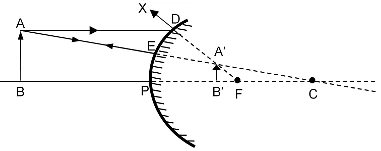
2nd case: object at infinity
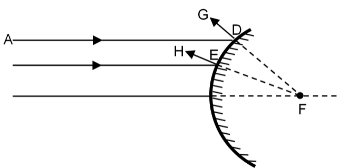
Uses of concave Mirror
- It is used in torches: It produces a powerful beam of light rays that converge at infinity.
- It is used in making solar devices: It converges all the rays so when solar rays converge, they increase the temperature at that converging point.
- It is used as shaving mirror: When face is placed between the pole and the focus, it gives virtual, erect and magnified image.
Uses of Convex Mirror
- It is used as rear view mirror: It gives virtual and diminished image. It covers a wide view and the image formed is within the focus

Mirror Formula
Linear Magnification is defined as the height of image to the height of the object.
M = Size of the image/ Size of the image
Sign convention for concave mirror
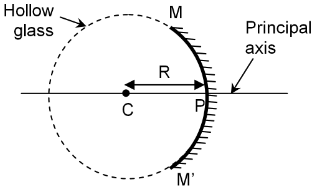
- U= negative
- F= negative
- V= positive (v-e)
- V= negative (r-i)
- M= negative (v-e)
- M= negative (r-i)
Sign convention for convex mirror
- U= negative
- F= positive
- V= positive (r-i)
- V= negative (v-e)
- M= positive (v-e)
- M= negative (r-i)
We know the nature of light and we have also learnt about one of its applications as reflection in part one. Now we are going to study another application of light that is refraction. To understand it, let’s look at how light passes through air, water, glass, etc. You will notice that whenever light moves in one medium, it follows a straight line path as shown in figure. But when it travels from one substance to another substance, its path doesn’t remain a straight line. It is deviated from the straight line path as shown in figure. These substances are regarded as medium or we can say that medium refers to any substance or material from which light can pass.
Types of medium
We have two types of mediums:
- Rarer medium: We can define rarer medium as the medium which has less density and speed of light is more.
Example: air is rarer than water. - Denser Medium: It is that which has more density and speed of light is lesser in it.
Example: water is denser than air.
Please note the type of medium is comparative study as one medium can be rarer in one case and can be denser in another case. For example: water is denser than air but water is rarer in comparison to glass. This change in the path of light while travelling from one medium to another causes a change in the speed of light and is called refraction or we can say that the bending of light ray when it passes from one medium to another is called refraction.
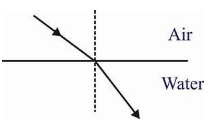 Like in the figure above, the speed of light decreases when it passes from air to water because water is denser than air.
Like in the figure above, the speed of light decreases when it passes from air to water because water is denser than air.
Important Terms
Look at the figure carefully then you will understand the terminology involved: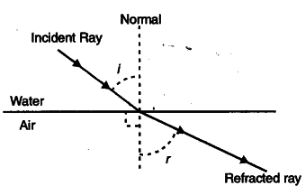
- Incident Ray: The ray that strikes the surface.
- Point of Incidence: Point where the incident ray strikes the surface.
- Refracted Ray: The ray that changes its path when it travels from one medium to another.
- Normal Ray: The perpendicular drawn to the point of incidence.
- Angle of Incidence: Angle between incident ray and the normal ray.
- Angle of Refraction: Angle between refracted ray and the normal ray.
Law of Refraction
These are the laws obeyed by the surface from wherever the refraction takes place :
- Incident ray, normal ray and the refracted ray all lie in the same plane.
- The ratio of sine of angle of incidence to the sine of the angle of refraction is always constant for a particular pair of media.
i.e.: sin i/sin r = constant (Snell’s law)
(i) Refraction when light passes from denser to rarer medium
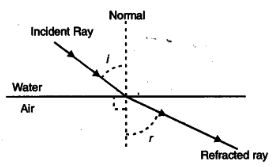
When light passes from a denser to a rarer medium, it gets deflected away from the normal and in this case the angle of refraction is greater than the angle of incidence.
(ii) Refraction when light passes from rarer to denser medium
Likewise when it passes from rarer to denser, it moves towards normal and in this case the angle of refraction is less than the angle of incidence.
(iii) Refractive Index
This is another physical quantity that is related to refraction. It is defined as the speed of light in vacuum /speed of light in a given medium or it is the ratio of the sine of the angle of incidence to the sine of the angle of refraction is always constant for a particular pair of media.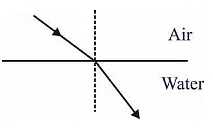
Note: The refractive index is denoted by ‘n’ and it has no units. Also, value of refractive index for one medium with respect to another is the reciprocal of the value of refractive index of the second to the first medium.
(iv) Reversibility of path of light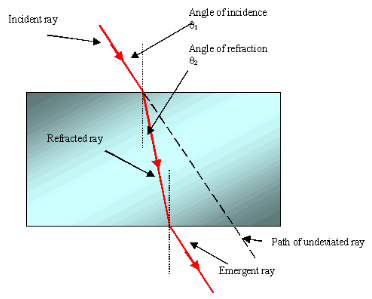
We have noticed that the path of light is reversible. For example: If light enters as shown in the figure, it undergoes refraction as shown and also, if the light enters in the opposite manner, it will follow the same sequence. The ray that moves out to its original medium after passing through certain medium is emergent ray and it can be defined as:
- Emergent Ray: The ray that passes through a certain media and then returns to its original media is known as the emergent ray.
- Angle of Emergence: The angle between a normal ray and an emergent ray is known as angle of emergence.
Lateral Displacement
An interesting phenomenon that we notice while studying reversibility of light is lateral displacement. It can be defined as the perpendicular shift in the path of incident ray when it travels through a certain medium and then returns to its original medium.
(i) Consequences of Refraction
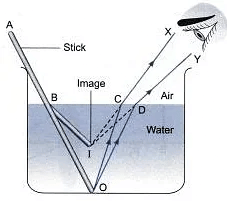
- A stick immersed in water appears to be bent: A stick immersed in water reflects light rays. These rays when travelling in water, travel in a straight line path but when they go from water to air, they deviate from their path and get deflected away from the normal. When these refracted rays are produced, they appear to meet at point “I” which is higher than the actual point that is ‘O’. Therefore, a stick immersed in water appears to be bent due to refraction.
- The water level appears to be raised: When rays moves out from water to air, they will bend away from normal and when produced, they meet at point “I” which is above actual point ‘O’. So, apparent image is at ‘O’ and actual image is at ‘I’.
(ii) Refraction of light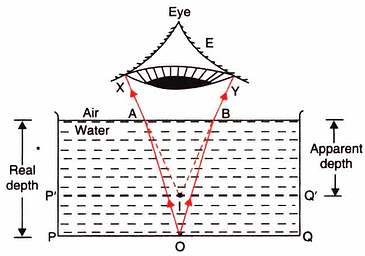
Lens

It is a portion of a transparent optical material having one or two spherical faces. Types of Lens are:
- Concave lens
- Convex lens
The terminology used for lenses:
- Optical Centre: It is the centre of the lens.
- P Axis: It is the line passing straight through optical centre.
- Focus: Point where refracted rays meet or appear to meet.
- Focal length: The distance between the focus and the optical centre.
- 2f: Twice of focal length.
- Nature: The rays that fall on convex lens, after refraction, meet at one point so it is a converging lens.

On the other hand, a concave lens splits all refracted rays in different directions, so it is a diverging lens.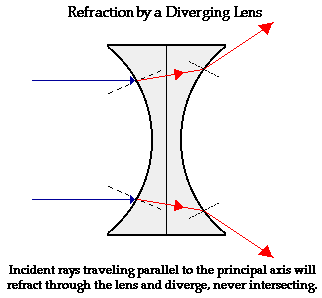
Power of Lens
It is defined as the ability of the lens to converge or diverge rays.
- Formula: P = 1/f(m)
- Unit: Dioptre
- For converging Lens: convex + dioptre
- For diverging lens: concave: -ve dioptre
Sign convention for convex and concave lens
- U = negative for both
- V = positive for real inverted and negative for virtual erect
- F = positive for convex lens and negative for concave lens
- M = positive for virtual erect image and negative for real inverted image
- H = positive for virtual erect image and negative for real inverted
|
16 videos|73 docs|48 tests
|
FAQs on Light - Science Olympiad for Class 10
| 1. What is reflection of light and how does it occur? |  |
| 2. What are the laws of reflection? |  |
| 3. What are the different types of mirrors used in everyday life? |  |
| 4. How do concave and convex mirrors differ in image formation? |  |
| 5. What is the importance of reflection in daily life? |  |

